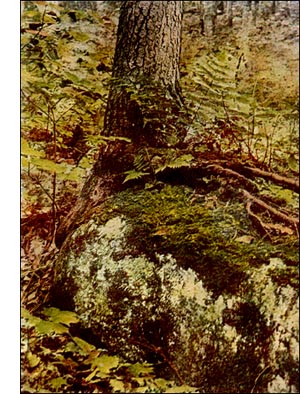Alpine Haircap Moss
 The Alpine Hair-cap Moss, Pogonatuna. Alpinum, (L.) Roehl.
The Alpine Hair-cap Moss, Pogonatuna. Alpinum, (L.) Roehl.Habit and habitat.- Growing in wide mats on rough stony and grassy places on all mountains. This is a pretty moss, larger thin most Hair-cap mosses and may be readily distinguished from the others by its smooth spore-case, narrower at the mouth than below, obliquely inclined to the red pedicel, and by its veil which does not reach to the base of the spore-case.
Name. -The name refers to its habit ofgrowing in mountain regions.
Plant (gametophyte).-Erect, 2 1/2 to 7 inches high, the branches at taining an equal height, and densely leafy; stems naked and subterra nean at the base. Male plants 1 to 2 1/2 inches high.
Leaves. - Erect, or recurved, narrowly lance-shaped; apex awl-shaped, spiny on the back; base white, sheathing, margins incurved, red, serrate; lamellae numerous 20 to 30, covering most of the upper half of the blade, 6 to 7 cells deep, the terminal cell oval in section with tiny projection (papillose).
Leaves at the base of the pedicel (perichaetial leaves).-Sheathing, longer, without lamellae.
Habit of flowering.-Male and female flowers on the summits of separate plants, (dioicous).
Veil (calyptra).-Hairy, not covering the spore-case.
Spore-case.-Nearly cylindrical to egg-shaped, smooth, light-green, inclined or horizontal, somewhat curved.
Pedicel (seta).-Flexuose, 1 to 2 inches long.
Lid (operculum).-Small with a slender beak.
Teeth ( peristome).-Thirty-two in number, blunt.
Spores.-Mature in late summer.
Distribution.-In mountainous regions.